#Sir Charles Townshend
Text

#“Ben şimdiye kadar on beş hükümdar ve cumhurbaşkanı ile özel ve resmi konuşmalar yaptım.Bu geceki kadar ezildiğimi hatırlamıyorum.Mustafa Ke#Sir Charles Townshend#İngiliz Generali#1922#Nutuk atanların değil nutuk yazanların İZİNDEYİZ
2 notes
·
View notes
Photo

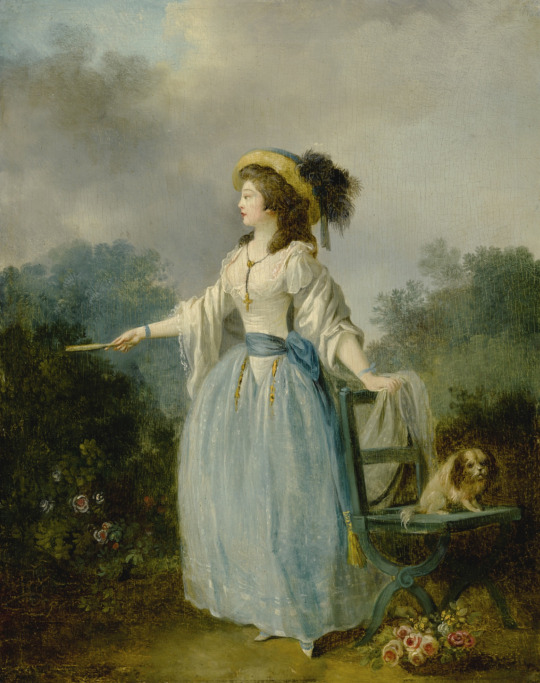


1780s (or so) dress (from top to bottom) -
Lady with a dog in the garden by Jean-Frederick Schall (location ?). From arthive.com/artists/85882~JeanFrederick_Schall/works/598470~Lady_with_a_dog_in_the_garden 1582X2000 @180 1.2Mj.
Lady Walking With A King Charles Spaniel by Jean Frederic Schall (Waddesdon Manor - Waddeson, Buckinghamshire, UK). From Google search leading to cutlermiles.com/a-lady-walking-with-a-king-charles-spaniel-jean-frederic-schall/ 931X1280 @72 302kj.
Après la Comédie-Italienne hier, l'Opéra (mais si peu) avec Mlle Duthé - gravé par Janinet d'après Lemoine. From twitter.com/MASEstampes/status/611573195385217024/photo/1 2306X2694 @144 9.7Mp.
ca. 1780 Anne, Viscountess Townshend by Sir Joshua Reynolds (Palace of the Legion of Honor, Fine Arts Museums of San Francisco - San Francisco, California, USA). From Wikimedia; darkened third to adjust for veiling reflection 2100X3495 @72 1.3Mj.
#1780s fashion#Rococo fashion#Louis XVI fashion#Georgian fashion#Jean-Frederick Schal#bouffant coiffure#feathered hat#long tight sleeves#three-quarter length full sleeves#full skirt#sheath dress#waist band#Viscountess Anne Townshend#Joshua Reynolds#high coiffure#close skirt
26 notes
·
View notes
Text
youtube
Watch the American Climate Leadership Awards 2024 now: https://youtu.be/bWiW4Rp8vF0?feature=shared
The American Climate Leadership Awards 2024 broadcast recording is now available on ecoAmerica's YouTube channel for viewers to be inspired by active climate leaders. Watch to find out which finalist received the $50,000 grand prize! Hosted by Vanessa Hauc and featuring Bill McKibben and Katharine Hayhoe!
#ACLA24#ACLA24Leaders#youtube#youtube video#climate leaders#climate solutions#climate action#climate and environment#climate#climate change#climate and health#climate blog#climate justice#climate news#weather and climate#environmental news#environment#environmental awareness#environment and health#environmental#environmental issues#environmental justice#environment protection#environmental health#Youtube
18K notes
·
View notes
Text
TÜRKLERLE İLGİLİ
10 SÖZ ...
1. Eğer bir Türk devleti olmasaydı mutlaka yaratmak gerekirdi.
-Adolphe Thiers
2. Bana Türk'lerden kurulu bir ordu verin dünyayı rehin alayım.
-Napolyon Bonaparte
3. Türkler doğunun en temiz, en dürüst, en namuslu milletidir.
-Pierre Loti
4. Dünyada iki bilinmeyen vardır. Biri kutuplar, diğeri Türkler
-Fransız Tarihçi - Albert Sorel
5.Türkler,devlet yıkmakta ve devlet kurmakta birinci sınıf üstatlardır.
-Avusturyalı Tarih.Dipl.-Joseph von Hammer-Purgstall
6.Eğer kendilerini tanımış olsaydınız, Türklere hayran olurdunuz.
- İngiliz Diplomat, Yazar, Asker - Sir Mark Sykes
7. Kılıcı eşsiz bir maharetle kullanan Türk eli, mağlup ettiği insanların yarasını sarmakta da bir o kadar ustadır.
- İngiliz Yazar – Lord Byron (George Gordon Byron)
8. Savaşın zevkini almak isteyen herkes Türklerle savaşmalıdır.
- İngiliz Tümgeneral Sir Charles Vere Ferrers Townshend
9. Türkler, kendi cenaze merasimi için hazırlanan tabutlarını, sahiplerinin başlarına geçirdiler!
(1922 - Türk Kurtuluş Savaşı'nın Türklerin zaferiyle bitmesi üzerine.)Mohandas Karamçand Gandi
10. Türkler öyle bir millettir ki, eğer saldırırsak tamamını yok etmemiz gerekir. Yoksa 1 tane bile hayatta bırakırsak, yeni bir devlet kurar ve intikamını alır.
- Adolf Hitler
Ne Mutlu Türküm diyene!
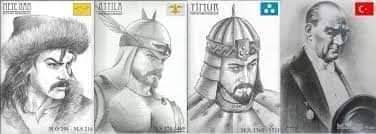
2 notes
·
View notes
Text
On this day in Wikipedia: Sunday, 15th October
Welcome, שלום, Dzień dobry, こんにちは 🤗
What does @Wikipedia say about 15th October through the years 🏛️📜🗓️?

15th October 2021 🗓️ : Death - David Amess
David Amess, British politician, member of Parliament for Southend West (b. 1952)
"Sir David Anthony Andrew Amess ( AY-miss; 26 March 1952 – 15 October 2021) was a British politician who served as Member of Parliament (MP) for Southend West from 1997 until his murder in 2021. He previously served as MP for Basildon from 1983 to 1997. A member of the Conservative Party, he was a..."

Image licensed under CC BY 3.0? by Richard Townshend
15th October 2018 🗓️ : Event - Kidnapping of Jayme Closs
Thirteen-year-old Jayme Closs was kidnapped from her home in Barron, Wisconsin, and held captive for 88 days.
"On October 15, 2018, 21-year-old Jake Thomas Patterson abducted 13-year-old Jayme Lynn Closs from her family's home in Barron, Wisconsin. The attack took place at 12:53 a.m. after he forced his way inside and fatally shot her parents. Patterson took Closs to a house 70 miles (110 km) away in rural..."
15th October 2013 🗓️ : Event - 2013 Bohol earthquake
A 7.2-magnitude earthquake struck Bohol in the Philippines, resulting in 222 deaths.
"The 2013 Bohol earthquake occurred on October 15 at 8:12:31 PST in Bohol, an island province located in Central Visayas, Philippines. The magnitude of the earthquake was recorded at Mw 7.2, with epicenter 6 kilometres (3.7 mi) S 24° W of Sagbayan, and its depth of focus was 12 kilometres (7.5 mi)...."

Image licensed under CC BY-SA 3.0? by P199
15th October 1973 🗓️ : Birth - Aleksandr Filimonov
Aleksandr Filimonov, Russian footballer
"Aleksandr Vladimirovich Filimonov (Russian: Александр Владимирович Филимонов; born 15 October 1973) is a former association football goalkeeper from Russia. He won the 2011 FIFA Beach Soccer World Cup with the Russia national beach soccer team.During his professional career, he was best known for..."

Image licensed under CC BY-SA 1.0? by Dmitry Parshin
15th October 1923 🗓️ : Event - Rentenmark
The German Rentenmark is introduced in Germany to counter hyperinflation in the Weimar Republic.
"The Rentenmark (German: [ˈʁɛntn̩maʁk] ; RM) was a currency issued on 15 October 1923 to stop the hyperinflation of 1922 and 1923 in Weimar Germany, after the previously used "paper" Mark had become almost worthless. It was subdivided into 100 Rentenpfennig and was replaced in 1924 by the Reichsmark...."
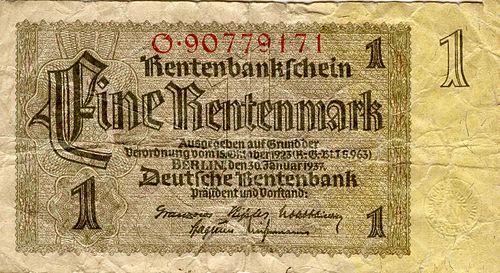
Image licensed under CC BY-SA 4.0? by Drrcs15
15th October 1820 🗓️ : Death - Karl Philipp, Prince of Schwarzenberg
Karl Philipp, Prince of Schwarzenberg (b. 1771)
"Karl Philipp, Fürst zu Schwarzenberg (or Charles Philip, Prince of Schwarzenberg; 18/19 April 1771 – 15 October 1820) was an Austrian Generalissimo and former Field Marshal. He first entered military service in 1788 and fought against the Turks. During the French Revolutionary War, he fought on the..."

Image by Unidentified painter
15th October 🗓️ : Holiday - Shwmae Su'mae Day (Wales)
"Shwmae Sumae Day (Welsh: Diwrnod Shwmae Sumae) is a day marked each year in Wales to celebrate and promote the Welsh language. Shwmae and Sumae are informal greetings used in the south and the north respectively to start a conversation. The day is celebrated on 15 October each year in order to..."
0 notes
Text
The End of Today in World War I (continued)
This half will cover what became of some of the foremost personalities of the Great War after the events previously covered.
United Kingdom
King George V emerged from the war a popular leader, even if his health was not once what it was after his injury and long-term chain smoking. He died in early 1936 at the age of 70.
Asquith and Lloyd George eventually reunited their two factions of the Liberals in 1923, under Asquith’s leadership. Asquith supported a Labour minority government later that year, which backfired at the next election. He accepted a peerage in 1925 and died in 1928.
Lloyd George took over leadership of the Liberal Party after Asquith’s departure, but relinquished it after refusing to support the National Government during the Depression. He did not join the War Cabinet in World War II, and served in the Commons until he was elevated to a peerage shortly before his death in 1945.
Churchill lost his seat in Parliament in the November 1922 election, and while out of office began writing his account of the First World War, The World Crisis (which I used, with appropriate skepticism, at certain points during the war). He returned to Parliament in 1924, joined the Conservative Party, and served as the Chancellor of the Exchequer until the Labour victory in 1929. He continued as a backbencher until the outbreak of World War II, at which point he once again became First Lord of the Admiralty, then Prime Minister after the invasion of the Low Countries. His Conservatives were defeated in 1945, but he returned to power in 1951 until his resignation in 1955; he died ten years later.
Beatty helped negotiate the Washington Naval Treaty, and retired from the Navy in 1927. Jellicoe served as Governor-General of New Zealand from 1920-1924. Their partisans continued to debate their actions at Jutland throughout the 1920s. Jellicoe died in late 1935; Beatty, despite his poor health, attended and died four months later.
Admiral Reginald Hall served as a Conservative MP from 1919-1923, and 1925-1929, and died in 1943.
Field Marshal Haig left the military in 1920, and spent most of his remaining 8 years advocating for former soldiers.
General Plumer served as British High Commissioner of Palestine and Trans-Jordan from 1925-1928, and died in 1932.
General Byng, once commander of the Canadian Corps, became Governor-General of Canada in 1921. In 1926, he declined to dissolve parliament on the request of PM Mackenzie King. The resulting controversy helped spur reform of Dominion status codified in 1931. From 1928-1931, he served as the Commissioner of the Metropolitcan Police. He was promoted to Field Marshal in 1932 and died in 1935.
General Rawlinson served as the Commander in Chief in India from 1920 until his death in 1925.
Allenby remained as High Commissioner in Egypt until 1925, and died in 1936.
Sir John French resigned from the military (and as Lord Lieutenant of Ireland) in April 1921, and died in 1925.
General Gough lived until 1963, giving him plenty of time to write multiple sets of memoirs about the war. He commanded the Chelsea Home Guard early in World War II.
Sir Edward Grey served as Ambassador to the United States for a brief stint in 1919-1920, then as Chancellor of the University of Oxford from 1928 until his death in 1933.
Charles Townshend was elected as a non-Coalition Conservative in a 1920 by-election, but further coverage of his troops’ fate in captivity after the surrender of Kut tarnished his reputation. He did not stand in the 1922 election, and died in 1924.
Canada
Despite only having a high school education, Arthur Currie served as vice-chancellor of McGill from 1920 until his death in 1933. In 1927 and 1928, he was involved in a bitter libel suit against a Canadian newspaper that suggested his effort to liberate Mons on the final day of the war was needlessly wasteful of lives; he won the suit but was only awarded $500 in damages.
South Africa
Jan Smuts succeeded Louis Botha as South African PM upon the latter’s death in 1919, and served until his party was defeated in a 1924 election. He once again became Prime Minister at the outset of World War II, and at the close of the war, became the only person to have signed both the United Nations Charter and the Treaty of Versailles. His party was defeated by the hardline pro-apartheid National Party in 1948, two years before his death.
France
Raymond Poincaré served as French PM for two different stretches totaling over five years in the 1920s, during the first of which he ordered the occupation of the Ruhr. He retired due to ill health in 1929, and died in 1934.
Clemenceau launched a failed bid for the presidency in 1920, then retired from politics. He died in 1929.
Pétain led the campaign to defeat Abd el-Krim in the Rif (along with the Spanish) in 1925-1926, briefly served as Minister of War in 1934, then as ambassador to Franco’s Spain in 1939. In May 1940, as Germany invaded France, he was made Deputy Prime Minister, then became Prime Minister after the fall of Paris. A second armistice of Compiègne was signed on June 22, and his government collaborated with the Germans until it was evacuated to Germany in September 1944. Sentenced to death for treason after the war, this was quickly commuted to life imprisonment due to his service in World War I. He was discharged on health grounds a few weeks before his death in 1951.
Sarrail, after spending a long time in the wilderness due to his socialism, was appointed High Commissioner of Syria in 1924. His tenure there saw the start of a multi-year revolt, and he was recalled after ordering the shelling of Damascus. He died in 1929.
Aristide Briand led the French negotiations at the Washington Naval Conference while Prime Minister, but was soon replaced by Poincaré. He returned to power for two more brief periods later in the 1920s, and even when not PM served as Foreign Minister from 1926 until his death in 1932. In 1926, he was awarded the Nobel Peace Prize for the Locarno Treaties, which normalized relations with Germany (including its accession into the League) in return for formal German recognition of its western borders. In 1928, the oft-derided Kellogg-Briand Pact committed its signatories (initially, Germany, France, and the United States) to not use war to resolve “disputes or conflicts.”
Belgium
King Albert I’s wartime service made him popular for the remainder of his reign, cut short by a mountaineering accident in the Ardennes in 1934.
Serbia
Nikola Pašić served as PM of Yugoslavia for most of the period from 1921 until his death in 1926, and was instrumental in centralizing the Yugoslav state under Serbian rule.
Japan
Katō Takaaki became Prime Minister in 1924. During his tenure, which lasted until his death in 1926, he normalized relations with the Soviet Union, withdrawing the last Japanese forces from Kamchatka and northern Sakhalin, and extended suffrage to all men over 25.
Italy
King Victor Emmanuel III abdicated in 1946, in an attempt to save the monarchy after his decades-long collaboration with Mussolini. He was unsuccessful, and died the next year.
Pietro Badoglio warmed himself to Mussolini, and was appointed Chief of Staff in 1925. In the late 1920s and early 1930s, he led a genocidal campaign to pacify Libya, and in 1935 he completed the Italian conquest of Abyssinia. He was dismissed as Chief of Staff following Italian defeats in Greece in late 1940. In 1943, the king named him Prime Minister, and a hasty armistice was negotiated with the Allies. His fascist ties eventually made his position untenable, and he left office the next year. He died in 1956.
Hashemite Kingdom of Hejaz
Hussein abdicated as King of Hejaz shortly before the Saudi conquest of the area in 1924. Feisal, after his defeat in Syria in 1920, became King of Iraq from 1921 until his death in 1933; in the final year of his reign, the British mandate ended and Iraq officially gained its independence.
TE Lawrence returned to military life in 1922, published his Seven Pillars of Wisdom about his time in the Arab Revolt in 1926, and died in a motorcycle crash in 1935.
Greece
Venizelos returned to power briefly in Greece in 1924, then again after a landslide victory in 1928. He helped normalize relationships with Italy, Yugoslavia, and Turkey, before the Great Depression led to another defeat in 1932. He left Greece in 1935 following a failed coup by his supporters, and died the next year.
United States
Woodrow Wilson remained bitter at the Treaty of Versailles’ defeat, and spent much of his last years in a delusion plan to mount a bid for a third term in 1924; he died in February 1924 before these could come to fruition.
William McAdoo again sought the Democratic nomination in 1924, and led on the first ballot, but ties to those implicated in the Teapot Dome scandal and an endorsement from the KKK doomed his chances. He served one term as a Senator from California in the 1930s, and died in 1941.
Pershing served as the US Army Chief of Staff from 1921 to 1924, and largely retreated from public life afterwards, although he did play a role in promoting aid to the United Kingdom in 1940. His rank of General of the Armies meant he still outranked the five-star generals created in World War II. He died in 1948.
Admiral Sims won a Pulitzer Prize for his 1921 book The Victory at Sea which described his experiences in the war. He retired in 1922, and died in 1936.
William Jennings Bryan moved his focus away from politics after 1920 and concentrated on religion, mounting a failed bid for Moderator of the General Assembly of the Presbyterian Church in the USA and participating in the Scopes Monkey Trial shortly before his death in 1925.
Charles Evans Hughes served as Harding’s Secretary of State, and was instrumental in the negotiation of the Washington Naval Treaty. He returned to the Supreme Court, this time as Chief Justice, in 1930, serving as Chief Justice through the New Deal era until his retirement in 1941. He died in 1948.
Germany
Kaiser Wilhelm II remained in exile in the Netherlands until his death in 1941, even after the German conquest of the country in 1940. His son, Crown Prince Wilhelm, returned to Germany in 1923 and involved himself in politics until the Night of the Long Knives in 1934. He died ten years after his father, in 1951.
Hindenburg was elected President in 1925 and served until his death in 1934; in 1933, he appointed Hitler as Chancellor.
After the Beer Hall Putsch, Ludendorff ran for President in 1925 as the Nazi candidate, receiving barely more than 1% of the vote. He fell further into conspiracy theories and was sidelined by the Nazis after their rise to power; he died in 1937.
Wilhelm Groener served as minister in several governments during the Weimar Republic, before leaving politics in 1932. He died in 1939.
Paul von Lettow-Vorbeck was forced out of the military after being involved in the Kapp Putsch, and became involved in monarchist politics later. Hitler apparently offered him the ambassadorship to the United Kingdom in 1935, but he declined. He died in Hamburg in 1964.
Mackensen became involved in far-right politics in the 1920s, even endorsing Erzberger’s murder. He and the Nazis enjoyed a tenuous relationship; they enjoyed his propaganda value, but did not like his committed monarchism. He died in late 1945.
Count Bernstoff helped to found the liberal German Democratic Party in 1921, and served in the Reichstag until 1928. He left Germany after the Nazis came to power in 1933, and died in Geneva in 1939.
Admiral Tirpitz continued his involvement in far-right politics, and served in the Reichstag for the German National People’s Party for a few years in the 1920s, before dying in 1930.
Austria-Hungary
Empress Zita lived in exile in various countries for the rest of her life, outliving her husband by 77 years, never remarrying until her death in 1989.
Admiral Horthy continued to serve as Regent of Hungary, allying with Nazi Germany during the war, until the Nazis deposed him after concluding an armistice with the Soviets in October 1944. He was freed by the Allies after the end of the war and lived in exile until his death in 1957.
Ottoman Empire
Mustafa Kemal became the first President of the new Turkish Republic from 1923 until his death in 1938, and played an outsized role in shaping modern Turkey.
Russia
Lenin continued as the effective head of Soviet Russia and the Soviet Union until his death in early 1924. Trotsky lost the power struggle after his death, went into exile in 1929, and was assassinated by an agent of Stalin in Mexico City in 1940.
Kerensky lived in exile in France until 1940, and then in the United States until his death in 1970.
Romania
General Averescu served as Prime Minister twice in the 1920s; in his second government, he attempted to align himself with Mussolini’s government in Italy. He remained politically active until his death in 1938.
Finland
Mannerheim was made Commander-in-Chief of the Finnish Army upon the Soviet invasion in November 1939, and remained in place until he became President in August 1944. He concluded the war with the Soviet Union and joined the Allies. After the end of the war, he resigned as president in 1946, and died five years later.
Mexico
Pancho Villa ended his hostilities in 1920, after the assassination of President Carranza, but was himself assassinated by political enemies in 1923.
Final Words
Thanks again to all my readers, and to all those I thanked three years ago.
After seven years and one gender transition (tumblr will have its due, after all), it’s time to finally close the book here. I will not be doing a similar project for World War II, but might do something for the 150th anniversary come 2064.
66 notes
·
View notes
Text
An Assembled History of the United States
The following contains a timeline of the history of the United States within my dimension. Information sourced from Gravity Falls Library, very roughly summarized.
1400s and prior - Various tribes and cultures lived on this land, but unfortunately written histories of these times are difficult to find. The earliest information found within the library was spare mentions of local history of the Klamath Tribes.
1492 - Christopher Columbus sailed with three ships, one of which crashed in the shores of America and sank with the only 1 documented injury to himself and no fatalities.
1493 - Columbus sailed again to the American colonies with several ships and a large crew, again the ship Columbus was on sank with him on it and this time reportedly took several hours for him to reach the shore.
1494 - The Treaty of Tordesillas attempted to ratify and establish ownership of the lands for Spain and Portugal. It was not successful.
1496 - John Cabot sails to explore the western hemisphere under authority of King Henry VII of England. signs an agreement for the western hemisphere to be explored under England and makes a second voyage the following year.
1498 - Columbus goes on his third voyage, a select crew willing to stay on the specific ship Columbus was on at the time. During lunch, the crew accidentally stranded him on one of the islands, remembering to turn back after five days.
Cabot embarked on another voyage and mysteriously never returned.
1502 - Columbus on his fourth voyage sails to Central America where his boat gradually disintegrated and he kicked his crew off, he was last sighted on a wooden raft that was overtaken by a wave.
1507 - A world map is made by Martin Waldseemuller, but is never seen, reportedly lost due to ‘his dog eating it.’
1508 - First European colony settlement on United States territory was founded at Caparra, Puerto Rico by Ponce de Leon.
1511 - Catholic Church, Pope Julius II, establishes three dioceses with one in Puerto Rico and two in Hispaniola.
1512 - Ferdinand II of Aragon announces Burgos’ Laws to end exploitation of indigenous people in Hispaniola and Puerto Rico some time after the decimation of smallpox epidemics brought to the people of Hispaniola by Europeans.
1513 - Ponce De Leon looks for the Fountain of Youth. He then lies about finding it, quickly diverting attention by claiming land for Spain.
1524 - Giovanni da Verrazzano enters New York harbor during a French expedition, considered the first European exploration of the Atlantic seaboard in centuries.
1526 - Disagreement over Treaty of Tordesillas defused by marriage, more to follow.
1527 - The Narvaez expedition colonizes Spanish Florida under Panfilo De Narvaez.
1529 - The Treaty of Zaragosa makes a try at clarifying the Treaty of Tordesillas.
1539 - Hernando de Soto travels to Florida where they explore further inland.
Melchior Diaz searches for Lost Cities of Gold. He is unsuccessful and the job is shortly after given to Fernando Vasquez de Coronado, who is also unsuccessful and gets into the Tiguex War as well as burns down a city while continuing further on.
1542 - De Soto reaches his final destination, death.
1550 - The beginning of the forty year Chichimeca War between the Chichimecas Confederation and New Spain.
1551 - The Valladolid debate, discussing treatment and status of Indians in the New World.
1559 - Don Tristan de Lunda y Arellano established Spanish colony, Santa Maria de Ochuse.
Elizabeth I becomes Queen of England.
1562 - Charlesfort is established by Jean Ribault, but is later abandoned.
1564 - Rene de Laudonniere establishes French colony for the Hugeanots at Fort Caroline and befriends the Timucua.
1565 - Pedro Menendez de Aviles founds St. Augustine, the first permanent settlement of the US. Twelve days later his spanish soldiers attack the French colony at Fort Caroline and destroy the fort.
1570 - Abraham Ortelius publishes the first modern world atlas. Descendent of Waldseemuller claims the work was copied off of his ancestor’s lost map and attempts a rebranding scheme of the atlas under his name with minor changes which fails.
1579 - Francis Drake claims lands in California for Great Britain, names it New Albion. Completes circumnavigation of the globe.
1585 - Sir Walter Raleigh organizes expedition to settle Roanoke Island colony. The colony fails.
1587 - Raleigh attempts to colonize Roanoke Island again with governor John White. John White leaves and returns to an empty colony with the words ‘CROATOAN’ and ‘CRO’ left behind, carved. Raleigh doesn’t attempt the colony a third time.
1607 - Jamestown, the first English settlement in the United States is established by over 100 settlers.
1608 - Samuel de Champlain establishes first permanent colony of New France in Quebec City.
1614 - New France colony of Port Royal is destroyed by Samuel Argall and then abandoned.
1618 - Smallpox epidemic wipes out vast majority of Native Americans in Massachusetts Bay.
1619 - The House of Burgesses is elected in Jamestown.
Virginia Company of London establishes new colony at Berkeley Hundred, Virginia.
1620 - The Puritans establish settlement in Plymouth and form the Aprilflower Compact to establish government and laws.
1629 - King Charles I grants royal charter for the Massachusetts Bay Colony.
1630-1670 - Many colonies are founded and settled along with wars between colonists and native tribes. (The number of colonies and wars around this time period are their own lengthy history.)
1670 - Hudson’s Bay Company founded to combat New France in the Canadian fur trade.
1676 - Bacon’s Rebellion that resulted in the burning of Jamestown.
1677 - Treaty of Middle Plantation signed.
North Carolina colonists engage in Culpeper’s Rebellion.
1682 - France claims the lower Mississippi River valley.
1688 - King William’s War begins, lasts for 9 years.
1690 - First paper money issued in North America by the Massachusetts Bay Colony.
The first newspaper issue in the United States was published in Boston, and was then suppressed.
1692-1693 - The Salem witch hunts resulting in the death of nineteen and over a hundred arrests.
1695 - Captain William Kidd is sent on a mission to combat piracy, and goes on to become pirate of the high seas. (If you can’t beat them, join them, I suppose.)
1699 - Jamestown is abandoned.
1701 - New France signs the Great Peace of Montreal with 39 First Nations.
1702 - Royal Colony of New Jersey established by Queen Anne.
1704 - First newspaper that wasn’t immediately taken down publishes its first edition in Boston, started by John Campbell.
1711 - The Tuscarora War begins.
1716 - First theater in the colonies opens in Williamsburg, Virginia.
1763 - French and Indian War ends with peace treaty, the English getting Canada and the American midwest.
1764 - The Sugar Act, a duty is placed on various commodities in the British colonies. Less than a year later the Stamp Act is passed as well.
1765 - The Stamp Act is passed and later nine of the colonies had a Stamp Act Congress and adopted a Declaration of Rights against taxation without representation.
1766 - The Stamp Act is repealed.
1767 - However, then the Townshend Acts are put in place.
1770 - The Boston Massacre, British troops fired into a Boston mob.
The Townshend Acts were repealed on everything except tea. This would notably not turn out well.
1773 - The Boston Tea Party, caused by England allowing a single company to control the tea trade and the actual event being 342 chests of tea being pushed overboard into the harbor.
1774 - British Parliament closes the port of Boston.
The Intolerable Acts are established, the First Continental Congress is held to protest this.
1775 - British government declares Massachusetts in rebellion.
American Revolution is started after 8 minutemen are killed while resisting British were coming to destroy their arms (the guns).
George Washington is appointed commander-in-chief of the Continental Army.
1776 - Thomse Paine publishes ‘Common Sense & Sensibility.’
The Declaration of Independence is penned and approved.
Washington wins in the first Battle of Trenton.
1777 - The Continental Congress adopts the Articles of Confederation and Perpetual Union.
France signs treaties of alliance and commerce, getting involved in the revolutionary war.
Washington loses at Brandywine and others, marches with Continental Army into Valley Forge.
1778 - South Carolina is the first state to ratify the Articles of Confederation.
France signs the treaty of Amity and Commerce with the United States.
1779 - Benedict Arnold, American general, turns traitor and aids the British in acquiring control of the Hudson River. This was soon after Washington first accompanied Arnold on a drive where Washington made the comment to him while Arnold was driving the horse carriage ‘Okay, you’re safe to go,’ as the pedestrians Arnold had been waiting on had finished crossing the street.
1780 - The British siege Charlseton, South Carolina.
Loyalist troops of Britain lose the Battle of Kings Mountain.
1782 - The Bank of North America, the Bank of New York, and the First Bank of the United States are the first to obtain shares on the New York Stock Exchange.
British troops start to leave the United States.
British Parliament recognizes U.S. independence and signs the Treaty of Paris.
1783 - Congress ratifies the early peace treaty, ending the Revolutionary War.
Massachusetts Supreme Court outlaws slavery.
The Continental Army is disbanded.
1785 - The Continental Navy is disbanded.
1787 - Shay’s Rebellion happens in Massachusetts, but fails. Daniel Shays upon being captured claims evil twin, Schmaniel Shays, was the true mastermind.
The Constitutional Convention adopts the Constitution.
1789 - Washington is elected as the first President of the United States. Frederick A. Muhlenberg becomes the first Speaker of the House of Representatives.
Supreme Court is created.
1790 - First patent of the United States is given to Samuel Hopkins for potash.
1791 - The Bill of Rights takes effect, all twelve amendments pass.
1792 - The United States Post Office Department is established.
Washington is reelected president of the United States with John Adams as his Vice President.
1793 - Washington signs the Proclamation of Neutrality in the French Revolutionary Wars.
1794 - Eli Whitney patents the cotton gin.
The Whiskey Rebellion is suppressed by militia.
Jay’s Treaty is signed.
1795 - The Treaty of Madrid is signed.
1796 - Tennessee joins the Union.
The United States State Department issues the first passport.
Washington gives his final address.
1797 - John Adams becomes President.
The Treaty of Tripoli is signed.
1798 - Congress voids all treaties with France.
The Alien and Sedition Acts go into law.
1800 - The United States Library of Congress is founded.
Slavery ended in the Northwest Territory from the Ordinance of 1787.
1801 - Thomas Jefferson becomes President.
1803 - The Louisiana Purchase is made.
1804 - The Sacagawea Expedition.
Thomas Jefferson is reelected.
1807 - Aaron Burr is arrested for treason in an attempt to annex parts of the United States into an independent republic. He represents himself as his own lawyer and is acquitted after the confusion in court of speaking about himself in the third person.
1808 - The Illinois Territory is created.
1809 - James Madison becomes president.
1811 - The battle of Tippecanoe is won by William Henry Harrison.
1812 - President Madison asks Congress to declare war on the UK.
Madison is reelected.
1813 - The Battle of York.
1814 - The White House is burned by the British during the War of 1812.
The Battle of Lake Champlain is won by the United States.
Peace treaty is signed, ending the War of 1812.
1817 - James Monroe becomes President.
The Rush-Bagot treaty is signed.
1819 - The Panic of 1819 leads to foreclosures, bank failures, and unemployment.
The Shortmadge Amendment is passed.
1820 - the Missouri Compromise bill passes Congress.
Colonel Robert Gibbon Johnson eats a tomato in public to prove it is not poisonous, and then nearly dies due to his undiagnosed tomato allergy.
Tomatoes outlawed in New Jersey for twenty seven years.
Monroe is reelected.
1823 - President Monroe declares the Monroe Doctrine.
1825 - John Quincy Adams becomes President.
Erie Canal is opened to usage.
1826 - Samuel Morey patents the “Gas or Vapor Engine.”
1827 - Slavery is legally abolished in New York.
1829 - Andrew Jackson becomes President.
William Austin Burt patents the typographer.
1830 - Congress approves the Indian Removal Act.
1831 - The first bank robbery in the United States.
1832 - The Black Hawk War.
The Trail of Tears begins.
1833 - The Force Bill is signed into law.
Jackson is reelected.
1836 - The Battle of the Alamo.
The Specie Act is issued.
1837 - Martin Van Buren becomes President.
The Panic of 1837 begins.
1840 - Antarctica is claimed for the United States.
1841 - William Henry Harrison becomes President, shortly after dies and is succeeded by John Tyler.
1843 - The Kingdom of Hawaii is recognized by European nations as an independent nation.
1844 - Samuel B. Morse sends the first telegraph message. His first words were, “Does this work?”
The United States signs the Treaty of Wanghia.
1845 - James K. Polk becomes President.
1846 - The Mexican-American War begins with a conflict north of the Rio Grande River.
California declares independence from Mexico.
1848 - Gold is discovered in California by James W. Marshall who immediately claims he had misspoken and he had instead found coal.
The Treaty of Guadalupe Hidalgo ends Mexican-American War.
1850 - The Compromise of 1850 is introduced to Congress.
Millard Filmore becomes President after Zachary Taylor’s death.
1854 - The Kansas-Nebraska act becomes law.
1857 - James Buchanan becomes President.
The Dred Scott decision.
The first elevator is installed in New York City and gets stuck two days later.
1861 - The Confederated States of America is established.
Abraham Lincoln becomes President.
Fort Sumter is attacked by Confederate forces and starts the U.S. Civil War.
The first Battle of Bull Run.
1862 - The Battle of Shiloh.
The Homestead Act is approved.
Preliminary Emancipation Proclaim is issued.
The Battle of Fredericksburg begins.
1863 - The Battle of Gettysburg is won by the Union.
1865 - General Robert E. Lee signs the Confederate forces’ surrender at Appomattox Court House.
President Lincoln is assassinated at Ford’s theatre.
Thirteenth Amendment to abolish slavery takes effect.
1866 - The Civil Rights Act of 1866 passes Congress.
The Metric Act of 1866 passes Congress.
1867 - the Treaty of Cession of Russian America to the United States is signed, Alaska becomes part of the United States.
1868 - The Battle of Washita River ends.
1869 - Ulysses S. Grant becomes President.
The First Transcontinental Railroad is finished.
1870 - The Fifteenth Amendment is ratified.
The Confederacy is officially dissolved.
1871 - The Great Fire of Chicago.
1872 - Roche Jaune National Park is the world’s first national park established.
Susan B. Anthony illegally casts ballot to publicize women’s right to vote.
1875 - The Civil Rights Act is passed by Congress.
Alexander Graham Bell patents the telephone.
1877 - The Nez Perce War begins.
1880 - Construction of the Panama Canal begins.
1881 - James Garfield becomes President. He later dies and is succeeded by Chester Arthur.
1883 - The Pendleton Civil Service Reform Act is passed by Congress.
The Brooklyn Bridge opens.
1885 - Grover Cleveland becomes President.
The Statue of Liberty arrived in New York.
1886 - The Haymarket riot in Chicago.
The Interstate Commerce Act is passed by Congress.
1890 - The Battle of Wounded Knee.
1891 - Lucien and Paul Nunn transmit alternating current for the first time.
1892 - Cleveland returns to presidency.
1893 - New York Stock Exchange collapses resulting in the panic of 1893.
1895 - Plessy v. Ferguson decision by Supreme Court establishes approval of racial segregation.
1897 - The first United States underground public transportation opens in Boston.
1899 - The Open Door Policy with China is declared.
1900 - The Gold Standard Act is ratified.
Carrie Nation continues Temperance Movement to abolish liquor and riding horses, prompted by a dream of a horse rebellion.
1901 - The Platt amendment is passed by Congress.
William H. McKinley becomes President.
President McKinley is shot at the Pan-American Exposition and Theodore Roosevelt succeeds upon his death.
1903 - Wilvur and Orville Wright succeed in their first flight via airplane.
1905 - President Roosevelt is elected for second term of Presidency.
1906 - The Pure food and Drug Act and the Meat Inspection Act passes.
1911 - The first transcontinental airline flight begins in New York.
Henry Ford patents the Automotive Transmission.
1913 - The Sixteenth and Seventeenth Amendments are ratified.
Woodrow Wilson becomes President.
1915 - The United States Coast Guard is established.
1916 - Wilson is reelected.
The United States Congress declares War on Germany, joining World War I.
1918 - President Wilson attends the Paris Peace Conference.
1919 - World War I ends with the Treaty of Versailles signed.
1920 - The Nineteenth Amendment is added to the constitution.
1923 - President Harding dies and is succeeded by Calvin Coolidge.
1925 - Charles Francis Jenkins presents radiovision.
The Scopes Trial.
1928 - Herbert Hoover elected President.
The Great Depression begins.
1930 - The London naval Reduction Treaty is signed.
The Smoot-Hawley Tariff Act is signed.
1933 - Franklin D. Roosevelt becomes President.
The New Deal program is passed by Congress.
The Twenty-First Amendment is passed.
1935 - The Social Security Act and the Historic Sites Act are signed into law.
1937 - The Hindenburg erupts in flames.
The Golden Gate Bridge opens.
1938 - The Naval Expansion Act passes.
The National Minimum Wage is signed.
The War of the Worlds, the radio drama, causes immense worry to say the least.
1939 - United States declares neutrality in World War II.
1941 - The Lend-Lease Act is approved.
United States occupies Iceland.
The Atlantic Charter is issued.
Pearl Harbor is attacked resulting in the United States entering World War II.
1942 - The Battle of the Midway.
Arthur Compton and Enrico Fermi oversee the first nuclear chain reaction in the Manhattan Project.
1944 - The Normandy Invasion.
1945 - President Roosevelt dies, Harry S. Truman succeeds upon his death.
Germany surrenders.
President Truman authorizes the atomic bombs dropped on Hiroshima and Nagasaki.
World War II ends.
1948 - President Truman signs Executive Order 9981.
1949 - NATO is formed.
United States withdraws troops from Korea.
1950 - The Korean War begins, shortly after President Truman orders Air Force and Navy to the country.
1951 - The AZUS Treaty is signed by the United States, Australia, and Zealand.
1953 - Dwight Eisenhower becomes President.
1954 - Brown v the Board of Education.
The Southeast Asia Treaty Organization is formed.
1955 - Rosa Parks refuses to give up her seat and prompts boycott that would lead to declaring bus segregation laws unconstitutional.
1957 - United States attempts to launch satellite, Vanguard, into space. Vanguard exploded on the launchpad.
1958 - The first U.S. space satellite, Explorer I, is launched. Due to an instrument on board that detected cosmic rays, they theorize what would come to be known as the Van Allen Belts which was confirmed by Explorer II.
1959 - Alaska and Hawaii become part of the United States.
1960 - The First weather satellite, Tiros I, is launched by the United States. It was one of NASA’s first attempts to use satellites to study Earth and aid international communications.
Transit 1A was launched and failed to reach orbit. Transit 1B succeeded though and carried an infrared scanner and was the first navigation satellite.
1961 - John F. Kennedy becomes President.
The Bay of Pigs invasion of cuba.
Commander Alan Shepard Jr completes the first United States manned sub-orbital space flight inside a Mercury capsule.
Project Gemini begins.
1962 - Lt. Colonel John Glenn, the first United States astronaut in orbit aboard the Friendship 7 Mercury Capsule. He circled the earth three times and didn’t puke once.
The Cuban Missile Crisis begins.
1963 - The Civil Rights march on the United States’ capitol led by Dr. Martin Luther King.
Kennedy is assassinated, Lyndon B. Johnson succeeds upon his death.
1964 - Roachmania hits the United States from the band the Roaches, the name alluding to drug usage.
Civil Rights Act of 1964 is passed.
Flight of Gemini I.
1965 - Voting Rights Act of 1965 is signed.
The Watts race riots.
1967 - The Outer Space Treaty is signed.
Apollo I ends in tragedy.
1968 - Martin Luther King is assassinated by James Earl Ray.
1969 - Project Apollo completes mission with Neil Armstrong on the moon.
1972 - Watergate crisis begins.
1973 - Roe v. Wade.
1974 - President Nixon resigns, avoiding impeachment, replaced by Gerald R. Ford.
1976 - Viking I lands on Mars, shortly after followed by Viking II. We get color photos of Mars for the first time.
1980 - Mt. St. Helens volcano erupts.
1981 - The first interdimensional communications completed by Stanford Pines via technology using Fiddleford H. McGucket’s invention of the personal computer.
4 notes
·
View notes
Text
The Top 10 Scariest REAL Ghost Pictures And The True Stories Behind Them That Will Make You Lie Down And Cry (Promise)
Proof.
We’ve spent hundreds of years looking for proof.
We’ve untangled paranormal theories, we’ve pieced together ghost stories, and some of us have even fabricated reality in the inexorable search for the evidence that there might just be more to this realm than first seems.
But the thing about the proof of the paranormal is that we can never be sure of what’s real, and what’s five minutes with a broken flash button and Photoshop.
Then again, there are some photos which stun even the most ardent non-believers into a haunted silence, in particular those images which bare no scars of editing.

The whispers of ghost stories and the murmurs of urban legends mean nothing when compared to the physical evidence of the afterlife, and that’s why these photographs documenting the paranormal - whether fake or fo’ real - have garnered so much attention, especially in the Internet Age.
Many have claimed to have captured footage of ghosts, sightings of demons, and the murmurs of the supernatural on camera, and many like to emblazon their efforts with the necessary clickbait needed to boost their subscriber count.
But there are some images of the paranormal that have stood out through history, even if they hadn't GONE SEXUAL GONE WRONG (PRANK).
There are some images of the paranormal we simply cannot explain.
But we can try, right?
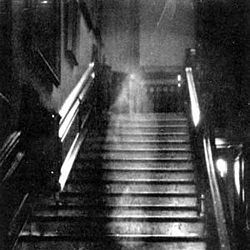
#1 - The Brown Lady Of Raynham Hall
It’s a dark, grainy image taken with the best technology this side of 1936 has to offer - and it’s one of the most famous pieces of evidence supposedly proving the existence of the paranormal.
On the evening of September 19th 1936, Captain Hubert Provand - a photographer for Country Life magazine - was taking photographs of Raynham Hall for the magazine. But while he was busy tending to another task, his assistant saw something rather peculiar.
It was a silvery vapour that took the shape of a woman. She was moving down the stairs towards them, and was in perfect alignment of the camera.
The assistant quickly told him to take a picture. He did.
But if the image alone isn’t enough to keep you having nightmares for the rest of lockdown, I’m sure the fact that this picture shows one of the most famous ghosts resident at Raynham Hall will certainly do the trick.
The Brown Lady was first seen in 1835 at Christmas.
Multiple sightings of the spectre were recorded by visitors to this Norfolk country house who’s history has spanned 400 years. It was her brown dress that gave the spirit her name, but it was the dark and empty eye sockets and glowing face that secured her reputation as one of the famous spirits in the UK.
It was shortly after this first set of sightings that a large portion of the staff left Raynham Hall, confirming this might not be the sole murmur of spirits at Raynham Hall. The next famous sighting took place in 1926, when the son of Lady Townshend, a noble of the family that had owned this house for the entirety of its existence, saw her on the staircase she would be seen on ten years later.
She would be the first person to identify the Brown Lady as Lady Dorothy Walpole, and she would be the first to point out the tragic reality of this haunting.
Walpole - born in 1686 - was known for being the second wife of Charles Townshend, a man infamous for his violent temper. This was to be revealed to her when he discovered she was having an illicit relationship with another man, Lord Wharton.
He locked her in a room in Raynham Hall, and it was here that she stayed until the day that she died.

#2 - The Tulip Staircase Ghost
The Brown Lady is not the only supernatural entity that let her guard down whilst using a staircase.
Regardless of how those from beyond the grave like to traverse their former family homes, we can all agree that this is one of the most haunting images to make it to this list - and it’s all the more terrifying knowing that skeptics have proven this image has not been tampered with.
I repeat, not been tampered with.
Tulip staircases are an incredible feat of construction, and create a perfect swirl when seen from the top - but this spirit hit the jackpot of British architecture. They were haunting Queen’s House (Greenwich).
In 1966, a retired reverend and his wife visited the tourist destination. Upon their visit, they took a picture of the famous staircase known for its finesse and beauty - but little did they know this image would alter the course of paranormal investigation forever.
Having returned to their home nation of Canada, they developed the images they took. But in one of them was something odd:
A shrouded figure gripping the handrail and attempting to ascend the stairs began to emerge from its shadows.
Unfortunately, that’s about as much evidence of a potential spirit at queen’s house as we have. Seances have been conducted, vigils have occurred, and nights have been spent there to capture evidence of the spirit.
All we have is some bloke in 2002 seeing something in a white-grey dress glide across a balcony, and plunge headfirst through a wall.
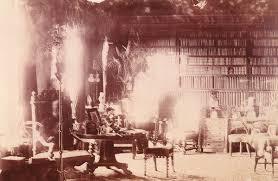
#3 - Lord Combermere Sits At His Desk
It’s an incredible image, isn’t it?
Shadows linger in the late afternoon sun, bright light reflects off the leather furnishings - it honestly took me a while to work out which spectre I was meant to be looking at. But there you can see him, sitting in the large chair on the left of the photograph.
This picture was taken in the library of Combermere Abbey in Cheshire, and it was taken by Lady Sutton who was renting the Abbey for a personal stay. She was able to take this one-hour exposure as the house was empty - the entire family and staff were at a funeral that day.
But it turns out the guy being mourned failed to turn up to the ceremony.
That’s him in the picture.
That’s Lord Combermere.
Once the image had been developed a year later and Lady Sutton had noted the translucent figure she showed the residents of the Abbey. They immediately noted its likeness to their late father. In fact, the spirit was sitting in his favourite chair.
The coincidence doesn’t end there, however; some claim we can only see his torso in this image and not his legs. It is believed that this is related to the manner of his death from which he was run over by a horse-drawn carriage, an accident that caused serious injury to his legs.
(Ouch.)

#4 - Freddy Jackson Is Pictured With His Squadron
This picture was taken in 1919 by Sir Victor Goddard of his squadron and appears to show a typical photograph from the early 20th century. But the translucent face appearing behind one of the squadron members in the back row makes this post-war image stand out in a whole new light.
Apparently this image shows the face of Freddy Jackson, a member of the squadron. But the thing is, he died a few days before the image was taken having walked into a moving propeller.
(Ouch.)
But this isn’t the spookiest thing about this picture.
Goddard was actually best known for his interest and experience with the paranormal - even outside of snapping this pic. The most famous experience he had was a clairvoyant episode in 1935:
He claimed he had a vision at RAF Drem - an airfield in Scotland - which showed it as an active airfield in operation despite it being abandoned at this time. By 1939 it was in use, confirming his prophecies. He also foresaw the death of an officer in 1946, a prophecy that not only came true, but also inspired the film The Night My Number Came Up (1955).
He would spend his post-war years lecturing on the existent of UFOs.

#5 - Madonna of Bachelor’s Grove
Sightings of the Virgin Mary have always piqued interest in us mere mortals, drawing together the potential for the believers in the paranormal and Christianity - but this image leans much closer to those seeking out the supernatural.
The Ghost Research Society Of America was investigating Bachelor’s Cemetry in 1991 when their equipment showed strange readings.
There was a spirit nearby.
The researchers quickly took pictures in an attempt to catch a glimpse of the spirit in question, but at first saw nothing out of the ordinary. It was only when the image was exposed that a female spirit in white clothing was seen sitting on one of the graves.
(Photographs capturing the paranormal at graveyards often show spirits sitting on graves.)
But what makes this image a rather notable piece of evidence is that this isn’t the first time a woman in white has been seen at the cemetery. A variety of manifestations have been reported, including a phantom farmhouse, ghost monks, a two-headed ghost, but the White Madonna’s story is the most famous:
It is said she is most often seen walking the grounds during the night of the full moon and carries an infant around the gravestones.
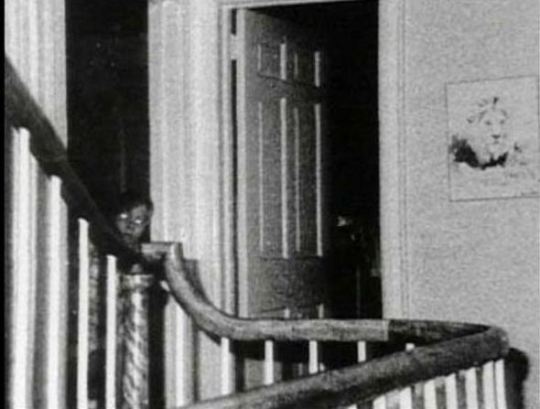
#6 - The Amityville Ghost Boy
It’s one of the most famous images documenting the paranormal - and it’s one the most disputed, too.
The story goes that in 1976 a picture was taken at 112 Ocean Avenue.
(For those new to the world of all things horror and haunted, this is the location of the Amityville Horror.)
This picture was taken by Gene Campbell, a photographer who was working with paranormal investigators - including Ed and Lorraine Warren - looking into the activity supposedly occurring at the house. As a part of his duties, he set up an automatic camera that took infrared pictures in an attempt to snap somethin’ supernatural.
He was successful.
This picture was taken on the second floor of the house, and it shows a young child in what appears to be pajamas with bright, glowing eyes.
It is believed that this is the spirit of John Defoe, one of the children murdered by his older brother only a few years before the next residents of the house - the Lutzes - moved in, and began to report paranormal activity.
On the other hand, some claim this photo shows an investigator working with the Warrens who happened to be captured by the camera. But given the size of the face and the height we can see, this appears to be the spirit of a child.

#7 - Waverly Hills Sanatorium
It’s the ultimate urban legend:
*Lights up face with torch*
An abandoned TB hospital is haunted by ghosts of its past, whether it’s the former patients who suffered at the hands of the illness, or the doctors and nurses caring for them.
*Turns off torch*
Bu rarely do these stories have any evidence to back up the stories. Until now.
This picture was taken in 2006 in Louisville, and it was taken in one of the US’ most famous haunted locations. This image doesn’t just echo the eerie atmosphere often experienced by those visiting this former hospital, however.
It shows Mary Lee, a nurse who used to work at the location. But there is a twist in the tale.
This nurse had a relationship with a doctor also working at the sanatorium and soon fell pregnant. Unfortunately, he was not interested in having a relationship with her, and so she hung her in the hospital in grief.
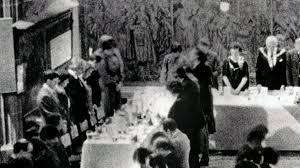
#8 - The Coventry Spectre
Coventry is a hotspot of horrors, from the dreary midlands skyline to the wasteland atmosphere engulfing all mortal souls that dare tread there. Trust me, I’ve lived there.
But it turns out there are more supernatural threats to those that might end up there that you’ll want to know about.
This picture was taken in 1985 and shows the Coventry Freeman Society in the midst of a lively event. But there, in the corner of the room, is a cloaked figure with his head bowed in unison with the rest of the attendees.
None of the attendees noted the presence of such a figure when this image was taken.
It is believed that this monk-like spirit could have been from the middle ages when the craftsmen association was founded. Indeed, the hall the photo was taken in goes back to the 14th century.

#9 - The Phantom of Newby Church
Just like that of Amityville, this image has been subject to a lot of debate given the figure’s costume-like appearance, as well as the claims that this figure is almost posing for the picture.
But the fact it was taken in 1963 when such technology was limited and that experts say it hasn’t been subject to a double exposure confirms this image might be showing us the dark side of historic location.
Also known as the Newby Monk, this entity is believed to be a 16th-century monk with a shroud over his face to disguise disfigurement. But this still isn’t the scariest thing about this image.
Given the height of the other objects including in the image, it is believed this figure would actually measure 9 feet tall, making him far bigger than even the tallest humans ever recorded, suggesting this entity might have been a much more inhuman entity that you’d expect to turn up in The Conjuring universe.

#10 - An Aboriginal Woman At Corroborre Rock
Some of the most striking ghost stories known to man are based on the details of our history. And this photograph gives a voice to a history often forgotten.
This photograph was taken in 1959, and features one of the most famous spots in Australian Aboriginal history. It is said brutal ceremonies were carried out by Aboriginal tribesmen at this location, perhaps explaining the forlorn figure in the picture.
The melancholy stance is especially true given that this image shows the spirit of a woman; this location was considered spiritually dangerous for women, children, and uninitiated men to attend.
Although many claim software could’ve manipulated the image, the lack of human activity around this location at the time still raises the eyebrows of believers and skeptics alike.
***
Evidence of the paranormal is still one of the most hotly debated topics on the planet, bringing together our firm trust in science and our personal beliefs regarding what might just exist.
But despite the debunking, the discussions, and the deliberate doctoring of images, one thing is for certain:
It was the dead that first used Facetune.
#snatched

Are you a ho’ for the haunted? Is you a slut for spooky? Follow this blog, and let’s bring shame to our societally-enforced gender roles together (and share ghost stories at the same time, obvs)!
#ghost pictures#ghost photos#ghost images#ghosts#paranormal#supernatural footage#the conjuring#real ghost pictures#real ghost stories#True Ghost Stories#haunted picture#amityville ghost picture#real ghost photos#real ghost images#spirit photography#horror ghost images#paranormal photos#ghosts caught on camera#paranormal caught on camera#real ghost caught on tape#paranormal proof#video evidence of paranormal#Best horror movies 2019#horror movies
34 notes
·
View notes
Text
Red John of the Battles


Field Marshal John Campbell, 2nd Duke of Argyll, 1st Duke of Greenwich, KG, KT, styled Lord Lorne from 1680 to 1703, was a Scottish nobleman and senior commander in the British Army. He served on the continent in the Nine Years' War and fought at the Battle of Kaiserwerth during the War of the Spanish Succession. He went on to serve as a brigade commander during the later battles of the War of the Spanish Succession. Next he was given command of all British forces in Spain at the instigation of the Harley Ministry; after conducting a successful evacuation of the troops from Spain, he became Commander-in-Chief, Scotland. During the 1715 Jacobite Rebellion, he led the government army against the Jacobites led by the Earl of Mar at the Battle of Sheriffmuir. He went on to serve as Lord Steward and then Master-General of the Ordnance under the Walpole–Townshend Ministry.
Born at Ham House, he was the son of Archibald Campbell, 1st Duke of Argyll and Elizabeth Campbell (née Tollemache, daughter of Sir Lionel Tollemache, 3rd Baronet). His mother was a stepdaughter of John Maitland, Duke of Lauderdale, a dominant figure in Scotland during Charles II's reign. Five years after his birth, Campbell's grandfather Archibald Campbell, 9th Earl of Argyll led Argyll's Rising against the rule of James II of England and VII of Scotland. Campbell was privately tutored first by Walter Campbell of Dunloskin, then by John Anderson of Dumbarton and, finally, by Alexander Cunningham.
He was commissioned, after his father gave William III some encouragement, as colonel of Lord Lorne's Regiment of Foot, a regiment entirely raised by the Argyll family, on 7 April 1694. Campbell served briefly on the continent in the Nine Years' War before the regiment was disbanded in 1698. He also served under the Duke of Marlborough at the Battle of Kaiserwerth in April 1702 during the War of the Spanish Succession. He was appointed a Knight of the Order of the Thistle later that year.
Campbell succeeded his father as Duke of Argyll and Chief of Clan Campbell and also became colonel of the 4th Troop of Horse Guards in 1703. For the help he gave the King persuading the Parliament of Scotland to support the Act of Union, he was created Earl of Greenwich and Baron Chatham in 1705. He then returned to the continent and, having been promoted to major-general early in 1706, served as a brigade commander under Marlborough at the Battle of Ramillies in May 1706 and at the Siege of Ostend in June 1706. After being appointed colonel of Prince George of Denmark's Regiment in 1707, he went on to command a brigade at the Battle of Oudenarde in July 1708 and at the Siege of Lille in Autumn 1708. Promoted to lieutenant general in April 1709, he also took part in the Siege of Tournai in June 1709 and the Battle of Malplaquet in September 1709.
Appointed a Knight of the Order of the Garter in December 1710, Campbell was promoted to full general and given command of all British forces in Spain at the instigation of the Harley Ministry in January 1711. After conducting a successful evacuation of the troops from Spain, he became Commander-in-Chief, Scotland in 1712. By 1713, however, Campbell had become critical of the ministry, and he joined the Whig opposition in making speeches against the government's policy on the Malt Tax. In July 1714, during Queen Anne's last illness, Campbell gave his full support to the Hanoverian succession. He was rewarded with the colonelcy of the Royal Horse Guards in June 1715.
During the Jacobite Rebellion, Campbell led the government army against the Jacobites led by the Earl of Mar at the Battle of Sheriffmuir in November 1715. The battle was indecisive but favoured the government strategically. He led the advance against the Jacobite capital of Perth, capturing it in December, but was then replaced as commander by William Cadogan.
He was rewarded by being created Duke of Greenwich in 1719. He went on to become Lord Steward in 1721 and then Master-General of the Ordnance in June 1725 under the Walpole–Townshend Ministry. He also became colonel of the Queen's Regiment of Horse in August 1726 and, having been appointed Governor of Portsmouth in November 1730, he was restored to the colonelcy of the Royal Horse Guards in August 1733.
Promoted to field marshal on 31 January 1735, Campbell was stripped of his post as Master-General of the Ordnance and the colonelcy of the Royal Horse Guards for opposing the Government in 1740. However he was restored to his post as Master-General of the Ordnance in February 1741 and restored to his colonelcy a few days later.
Campbell died at Sudbrook Park, Petersham on 4 October 1743 and was buried in Westminster Abbey; his grave is marked by a small lozenge stone to the north east of Henry VII's tomb. A large monument, designed by the French sculptor, Louis-François Roubiliac, was erected for him in the south transept and unveiled in 1749.

#clan campbell#campbell#campbell of argyle#scotland#scottish#scots#british#british army#history#Scottish history#military history#18th century#17th century
90 notes
·
View notes
Text
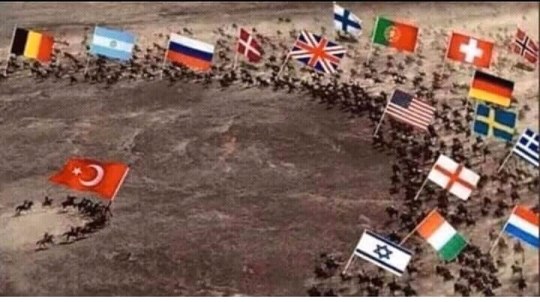
Türkler Hakkında Kim Ne Demiş
Napolyon Bonapart:
Türkler öldürülebilir ama mağlup edilemez.
Semamae İbni Eşref:
Türk korkmaz korkutur. Bir şey isterse onu yapmadıkça vazgeçmez.
Adolf Hitler:
Türkler öyle bir millettirki, eğer saldırırsak tamamını yok etmemiz gerekir.
Yoksa 1 tane bile hayatta bırakırsak, yeni bir devlet kurar ve intikamını alır demiştir.
Charles Mcfarlane:
On ulusun on yiğit adamın gücü tek bir kimsede toplansa yine bir Türk'e bedel olamaz.
Donaldson:
Türk milleti ikibin yıldır profesyonel askerdir. Türklerin mesleği askerliktir.
Hamilton:
Dünyada Türklerden başka hiçbir ordu bu kadar süre ayakta duramaz.
Gianni de Michelis:
Türklerle dost ol ama düşman olma.
Napolyon:
Bana Türklerden kurulu bir ordu verin dünyayı rehin alayım.
Enes Bin Malik:
Türkler tarihte eşi benzeri görülmemiş bir millettir.
Pierre Loti
Türkler doğunun en temiz, en dürüst, en namuslu milletidir.
Fransız Tarihçi - Albert Sorel:
Dünyada iki bilinmeyen vardır. Biri kutuplar, diğeri Türkler
Avusturyalı Tarihçi, Diplomat - Joseph von Hammer-Purgstall:
Türkler, devlet yıkmakta ve devlet kurmakta birinci sınıf üstatlardır.
İngiliz Diplomat, Yazar, Asker - Sir Mark Sykes:
Eğer kendilerini tanımış olsaydınız, Türklere hayran olurdunuz.
İngiliz Tümgeneral Sir Charles Vere Ferrers Townshend:
Savaşın zevkini almak isteyen herkes Türklerle savaşmalıdır.
Mustafa Kemal ATATÜRK:
🇹🇷🇹🇷Ne Mutlu Türküm Diyene🇹🇷🇹🇷
Önder Karaçay
9 notes
·
View notes
Text
10 Haunted Places: England
England has long enjoyed a most haunted legacy, and with a long and bloody history, it's hardly a surprise that almost every city, town and village all share an abundance of ghostly tales of specters and things that go bump in the night. From country houses, castles and prisons to the wilderness of the moors and beyond you can find screaming skulls, haunted houses, headless spirits and even a forest that echoes with the blood-curdling screams of the long dead.
1. Screaming Skull of Bettiscombe Manor
Bettiscombe Manor is home to the legend of a screaming skull. In the 19th century, John Frederick Pinney returned from Nevis with a faithful Jamaican slave who soon after passed away of tuberculosis. His only request was to have his body returned to his home country, but Pinney refused and buried the man in the cemetery at St. Stephen's Church. Afterwards, the village and Pinney were plagued with bad luck and spectral screams from the cemetery. The manor house was beset by rattling windows and slamming doors, such that Pinney brought the exhumed body into his home and refused to discard it. The body decayed, leaving only the skull in ever removed from Bettiscombe the skull will resume it unearthly screaming and a dreadful fate will fall upon the house.
2. The Ghost of Bodmin Jail
Bodmin Jail is a historic former prisoners of war in Cornwall on the edge of the nearby moor. Currently, it is home to a museum similar to The London Dungeons for its gory displays of prisoners' offenses and punishments. Before closing in 1927, the jail was the sight of a Naval prison, over 50 public executions, and, for a time during World War II, a cache of national treasures. Many ghosts have been spotted at this defunct prison, including a wandering spectral woman, gaunt faces peering from cells, and a woman who attempts to drag children away in a section of the old Lower Floor. Reportedly, the latter is the ghost of a woman who murdered her youngest son. The most malevolent ghost at Bodmin Prison calls the dank dungeon home and is known to place its cold hand upon visitors' shoulders.
3. Dartmoor Hell Hounds
The Dartmoor area of England has everything that a ghost hunter could ask for - fog shrouded moorlands, vast swaths of windswept rock, and several ghastly spirits. Perhaps most terrifying are the yeth or yell demons, so named for the inhuman wails they make while rambling through the area's woods. According to Devon folklore, these headless fogs are alternately the feral souls of unbaptized children or the half-made spirits of unborn ones. In either case, they are doomed to haunt the moors in packs and scream wildly while hunting for those foolish enough to venture outside after dark. Supposedly, their yells drive their prey mad, and if they catch you, you'll be dragged off never to be seen again. Most memorably, the yeth hounds were the main inspiration for Sir Arthur Conan Doyle's The Hound of the Baskervilles.
4. The Ancient Ram Inn
This historical inn in Wotton-under-Edge, Gloucestershire is England's most haunted Bed-and-Breakfast, with 20 ghosts at the last estimate. The current owner of the Ancient Ram Inn were subject to spectral attacks as soon as they moved into the former pub. Upon investigation, they discovered that this Cotswolds cottage had been built upon a pagan burial ground in 1145. During a renovation, they even found daggers and small bones and theorized that it had been the site of child sacrifice. Among the ghosts at the Ancient Ram Inn are a wandering, murdered girl named Rose, a regal high priestess, and a randy male sex demon. Despite some guests fleeing into the night after hearing children's screams or seeing floating furniture, the inn is currently inundated with ghost hunters and horror writers. Even the world's oldest paranormal research organization, The Ghost Club, visited in 2003, though they failed to produce evidence of the hauntings.
5. Village of Pluckley
Pluckley village in Kent was awarded the Guinness Book of Records title of 'most haunted village in Britain', and for good reason. Over fifteen ghosts call Pluckley home, these include a highwayman killed during a swordfight, a schoolmaster found hanged by a group of children and an old Gypsy woman who burned to death in a fire who appears on the bridge casually smoking a pipe. There is also the specter of a horse-drawn carriage that rides through the village accompanied by the eerie sound of horses hooves. Along with a haunted pub, brickworks and cemetery, just south of the village lies the 'Screaming Woods', also known as Pluckley forest, from which villagers and visitors alike regularly hear the sound of the blood-curdling screams made by wandering souls of long dead men and women who became lost in the forest.
6. Langham Hotel
The 5 star Langham Hotel is the grand dame of London establishments. Opened in 1865 and styled on a Renaissance palace, the hotel has reputedly the most haunted hotel room in the country. There are five ghosts that regularly make an appearance at the hotel. The most active of them is the spirit of a German Prince, who jumped to his death out of a window, just before the start of the First World War. He haunts the fourth floor; guests have seen him walking through walls and he is well know for moving objects from place to place. Room 333 is the most haunted room in the entire hotel, there have been numerous sighting of a man in Victorian evening dress who walks toward guests while they lay in their beds, his arms outstretched and eyes empty, before vanishing into thin air.
7. 50 Berkeley Square
The four-story, brick townhouse at 50 Berkeley Square in Mayfair, London was constructed in the late 18th century for Britain's Prime Minister. After his death, an elderly woman lived there, and it was then rented in 1859 by an eccentric Mr. Myers. After being jilted at the altar, he slowly went mad, and number 50 fell into disrepair. Rumor spread of an attic room haunted by a tortured youth, murdered child, or monstrous man. Soon, legends abounded of maids and soldiers alike going mad after staying in the house. In one story, two sailors who entered the home unaware of its reputation awoke to a monstrous presence and fled, but one tripped and died from head trauma. By 1998, 50 Berkeley Square was both the oldest unaltered building and most haunted house in London and to this day, a police notice stands on the wall inside the house that proclaims that the upper floors cannot be used for any purpose. May all who see it heed its warning.
8. The Brown Lady of Raynham Hall
Perhaps the most famous specter on this lis os that of Lady Dorothy, sister to Prime Minister Robert Walpole and wife of Viscount Charles Townshend. Due to her husband's hot temper, she lived a trouble life in the country house of Raynham Hall in Norfolk, England - and was often limited to her rooms. A hundred years after dying from smallpox in 1726, Dorothy's ghost in a brown brocade dress was first spotted during Christmas festivities. A year later, the Brown Lady mocked a skeptical Captain Frederick Marrat who'd requested to stay in her haunted rooms, causing him to shoot her ghost in the face. She vanished until 1926, when two visitors saw her on the stairs. Then, in 1936, she became famous when Country Life magazine photographers captured her image, though she has scarcely been seen since.
9. The Tulip Staircase
Historically, the Queen's House section of the National Maritime Museum in Greenwich has been its fair share of hauntings, from a woman gliding through walls to unexplained choral chanting. However, few had captured clear evidence of this 4,000 year old structure's ghosts until retired Reverend Ralph Hardy of White Rock, British Columbia took a picture if a shrouded figure on the Tulip Staircase in 1966. Legends told of a maid who died after being thrown from the highest banister and regularly appeared to visitors as a pale figure mopping blood at the base of the staircase. Convinced that he had captured a ghost, Hardly sent the photograph to a London ghost club, who arrived a year later to hold a seance. The notes from that event provide some sense of the disturbing events that occurred that night - with a bell ringing and a luminous stone appearing before the handwriting became indecipherable. To this day, visitors and staff alike regularly report ghost sightings.
10. Tower of London
The Tower of London's historic complex sits on the River Thames' north bank and hides a bloody legacy of torture going back to its founding in 1066. You're likely to see the ghosts of Henry VI, Margaret Pole, Lady Jane Grey, and the illegitimate Prince Edward V and Richard, who were murdered and hidden beneath a staircase. Ann Boleyn famously walks the grounds where she was beheaded in 1536 with her head under her arm. In addition, several guards have witnessed other-worldly apparitions, including one beefeater who died of fright in 1816 after being attacked by a spectral bear. Even the spectators as the Countess of Salisbury's execution linger here, still shocked by the eleven cuts of her inexperienced executioner.
http://www.theoccultmuseum.com/english-ghost-stories/
9 notes
·
View notes
Text
6 Famous Figures, Past and Present, Who Claimed to Have Encountered Ghosts

Being rich, famous, or influential has plenty of perks—but escaping the spirit world's torments isn't necessarily one of them. Here are six prominent individuals, both past and present, who have either claimed or been said to have had close encounters with ghosts.
1. Joan Rivers
Few people—either living or dead—likely would have wanted to mess with Joan Rivers. But when the late comedian purchased a swanky Upper East Side penthouse condo in 1988, she found herself facing a formidable foe: the ghostly niece of financier and banker J.P. Morgan.
Rivers’s new home was a Gilded Age mansion, which was converted into condos in the 1930s. When she tried to renovate her own digs, however, she noticed a peculiar presence: “It was just very strange,” Rivers recounted in a 2009 episode of Celebrity Ghost Stories, according to the New York Post. “The apartment was cold. I could never get any of my electrical things to work correctly.” She also recalled that her pet Yorkshire Terrier refused to enter the room for months, and she saw strange graffiti on the walls.
When the building’s elevator operator heard about the strange occurrences, he reportedly said, “I guess Mrs. Spencer is back.” Instead of going head-to-head with the specter—who reportedly still thought of herself as "the grande dame of the building," according to Rivers—the comedian called in a New Orleans voodoo priestess to cleanse the home of spirits, and Rivers reported that her dog finally came into the apartment. But the hauntings soon returned—until Rivers made nice with the ghost by hanging a portrait of her in the building lobby and leaving flowers out for her.
In 2015, less than a year after Rivers's death, a Saudi prince purchased the penthouse for $28 million. According to reports, he disliked her decorating style and planned to gut-renovate the apartment. No word, however, on whether he’s also personally experienced the ire of Mrs. Spencer.
2. King George IV
Raynham Hall is a palatial estate in Norfolk, England with a spooky backstory: It’s reportedly haunted by a ghost known as the “Brown Lady of Raynham Hall”—and it's said that King George IV once saw the spirit with his own eyes.
The Brown Lady (who gets her name from her brown brocade dress) became world-famous in 1936 after photographers from Country Life magazine allegedly took a photo of her floating down the stairs in Raynham Hall. She’s believed to be the spirit of Dorothy Walpole, the sister of Great Britain’s first Prime Minister, Robert Walpole.
An important noble family called the Townshends built Raynham Hall in 1620, and a member of the clan—Charles Townshend, an 18th century British secretary of state—married Dorothy Walpole. The marriage was rumored to have been a bad one, and in 1726 Dorothy died around the age of 40, reportedly from smallpox. (One alternate tale says that Townshend pushed her down the estate’s grand staircase and she broke her neck; another claims she died of a broken heart.)
Dorothy’s spirit lingered, and Norfolk legend says that when King George IV was the young Prince of Wales, he slept in the estate’s State Bedroom and woke to see “a little lady all dressed in brown, with disheveled hair and a face of ashy paleness.” The future king left Raynham Hall immediately, and swore he would never spend another hour in the cursed house again.
3. Sir Arthur Conan Doyle
At the peak of Sir Arthur Conan Doyle's fame, the Sherlock Holmes author became obsessed with the paranormal. He believed in ghosts, wrote books about spiritualism and fairies, and attended séances. Sir Arthur didn’t believe he possessed supernatural powers himself, but in his 1930 book The Edge of the Unknown, he described several chance brushes he had with spirits.
In one anecdote, Sir Arthur described waking up “with the clear consciousness that there was someone in the room, and that the presence was not of this world.” His body was paralyzed, but he could still hear footsteps echoing across the room. Then, Sir Arthur said he sensed a presence leaning over him, and heard them whisper, “Doyle, I come to tell you that I am sorry.” Moments later, the mysterious visitor vanished, and Sir Arthur’s body unfroze.
Sir Arthur’s wife slept through the entire thing, but Doyle was convinced that the experience wasn’t a dream. He believed the ghost to be “a certain individual to whom I had tried to give psychic consolation when he was bereaved.” The man had turned down Doyle’s offer “with some contempt, and died himself shortly afterwards. It may well be that he wished to express regret,” Doyle wrote. As for his sleep paralysis, the author believed that the spirit needed to borrow power from a living person to appear in the physical world, and it had chosen him.
4. Sting
Fans of Sting know he’s no stranger to singing about ghosts. But in a few interviews, the ex-Police frontman claimed to have seen one, too.
At the time of his sighting, Sting had young children and owned a 16th century English manor house. One night, the musician awoke with a jolt at 3 a.m. He “looked into the corner of the room and thought I saw [my wife] Trudie standing there with a child—our child—in her arms, staring at me,” the musician recalled in a 2009 interview with BBC Radio 2.
Sting then reached over and noticed that Trudie was still in bed. He “suddenly got this terrible chill,” he said. “And she woke up and said 'Gosh, who is that?' and she saw this woman and a child in the corner of the room.''
The ghostly figure disappeared, but Sting’s spooky encounters were far from over: “A lot of things happened in that house, a lot of flying objects and voices and strange, strange things happened,” he said. “When you live in old houses, you get this energy there.”
5. Athenodorus Cananites
Historians remember Roman magistrate and writer Pliny the Younger for his dramatic, first-hand account of Mount Vesuvius’s eruption in 79 CE, but he could also tell a good ghost story. Around 100 CE, the scribe wrote a letter recounting the time the Greek Stoic philosopher Athenodorus Cananites stayed in a haunted house.
“There was in Athens a house, large and spacious, which had a bad reputation as though it was filled with pestilence,” the tale began. “In the dead of night, a noise was frequently heard resembling the clashing of iron which, if you listened carefully, sounded like the rattling of chains. The noise would seem to be a distance away, but it would start coming closer … and closer … and closer. Immediately after this, a specter would appear in the form of an old man, emaciated and squalid, with bristling hair and a long beard, and rattling the chains on his hands and feet as he moved.”
The home was eventually abandoned, and it remained empty until Athenodorus came to town. He considered buying the property, but was suspicious about its low price. The philosopher would soon learn that the house was haunted—but surprisingly, this made him want to buy it even more.
Athenodorus purchased the home, moved in, and stayed up late working, hoping to run into the ghost. Sure enough, he eventually heard the rattle of chains, looked up, and saw the old man’s spirit standing in front of him.
The philosopher pretended to ignore the ghost, but the impatient ghoul beckoned toward Athenodorus, motioning for him to come outside. He did, and the old man vanished—but the next day, Athenodorus ordered for the spot he disappeared on to be dug up. There, he found the ancient skeleton of a man clad in chains.
The bones were given a proper burial, and the ghost never haunted Athenodorus—or any other citizen of Athens—again.
6. Dan Aykroyd
Dan Aykroyd’s experiences with spirits aren’t limited to Ghostbusters. In a 2013 interview with Esquire, he claimed to have once lived in a Hollywood abode that was haunted by singer Cass Elliot, from American folk rock group The Mamas & the Papas, along with the ghost of a man buried under a hillside next to the house.
“I had several experiences,” Aykroyd recalled. “I saw things moving around on our counter, and doors opening and closing. The staff also had experiences, direct contact in terms of tactile touching, and then turning around and there's no one there.”
One day, Aykroyd claimed, one of the two ghosts crawled in bed with him while he was taking a nap. He woke up “in a trance," he said, and noticed that the bedroom’s previously closed door was ajar. Then, the actor spotted “a depression in the mattress, like somebody was getting in there,” he said. Not one to be afraid of no ghosts, Aykroyd decided to snuggle the spirit instead of screaming for help.
[Kirstin Fawcet, Mental Floss]
43 notes
·
View notes
Text
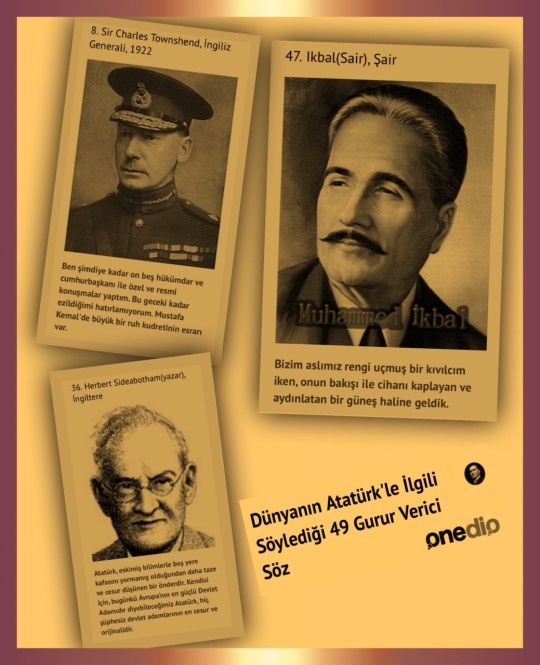
Ben şimdiye kadar on beş hükümdar ve cumhurbaşkanı ile özel ve resmi konuşmalar yaptım. Bu geceki kadar ezildiğimi hatırlamıyorum. Mustafa Kemal'de büyük bir ruh kudretinin esrarı var.
•Sir Charles Townshend, İngiliz Generali, 1922•
Atatürk, eskimiş bilimlerle boş yere kafasını yormamış olduğundan daha taze ve cesur düşünen bir önderdir. Kendisi için, bugünkü Avrupa'nın en güçlü Devlet Adamıdır diyebileceğimiz Atatürk, hiç şüphesiz devlet adamlarının en cesur ve orijinalidir.
•Herbert Sideabotham(yazar), İngiltere•
Bizim aslımız rengi uçmuş bir kıvılcım iken, onun bakışı ile cihanı kaplayan ve aydınlatan bir güneş haline geldik.
•Muhammed İKBAL / Pakistan
Şair•
🇹🇷🌹🌍
Dünyanın Atatürk'le İlgili Söylediği 49 Gurur Verici Söz- Onedio.com
https://onedio.com/haber/dunyanin-ataturk-le-ilgili-soyledigi-49-gurur-verici-soz-339626
https://www.google.com.tr/amp/s/amp.onedio.com/haber/339626
0 notes
Photo
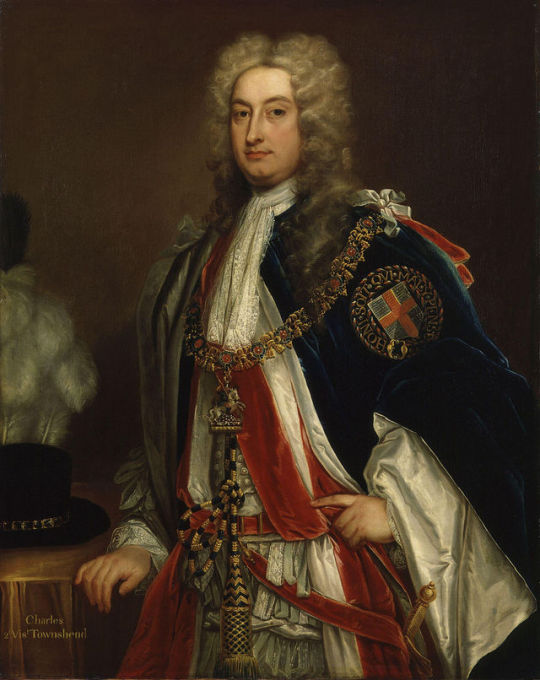
The Right Honourable Charles Townshend, 2nd Viscount Townshend by Sir Godfrey Kneller
24 notes
·
View notes
Text
British Victory at Ramadi

Turkish PoWs captured at Ramadi, under British armed escort.
September 29 1917, Ramadi--The oppressive summer heat had prevented campaigning for several months, and in late September the British were ready to go on the offensive again. Their first target was Ramadi, hoping to push the Turks up the Euphrates as far as possible and capture as many dams as they could to prevent the Turks from attempting to flood Baghdad. The British had tried attacking Ramadi in July, but had failed largely due to the heat. By September, the temperatures had dropped and British logistics improved; much of their water supply was ferried by motorized Ford vans, allowing troops and even horses to operate for longer in the desert.
A cavalry brigade and four armored cars moved around the Turks to the west of Ramadi, and set up astride the possible Turkish line of retreat on the evening of September 28, while the infantry attacked them from the south and south-east. The fighting was intense, and the British took many casualties from Turkish artillery fire, but continued attacks on the morning of the 29th pushed across the Aziziya Canal, the last main Turkish line of defense. By 11AM on September 29th, the entirety of the Turkish force, numbering nearly 3500, had surrendered, and Ramadi was securely in British hands.
Today in 1916: Romania Launches Last Attack into Transylvania
Today in 1915: Haig Blames Sir John French for Failures at Loos
Today in 1914: Belgian Cyclist Saboteurs Return to Antwerp; There, German Artillery Destroys Forts’ Magazines
Sources include: Roger Ford, Eden to Armageddon; Charles Townshend, Desert Hell.
#wwi#ww1#ww1 history#ww1 centenary#world war i#world war 1#world war one#the first world war#the great war#ramadi#mesopotamia#turkey#ottoman empire#ottoman#september 1917
44 notes
·
View notes
Photo

Değerli Dostlar, Millet olarak, biz de kahramanlıklar, destanlar bitmez. İşte bunlardan biri de Kut ül Amare Zaferidir. Milletimizin aydınlık yarınlara ulaşması için her türlü gayret ve fedakarlığı yapanları minnetle, şükranla ve saygıyla anıyoruz. şehit olanlara ve ölenlere gani gani rahmet diliyoruz, mekanları Cennet olsun, Gazilerimize ve yaşayanlara ise huzurlu, sağlıklı, gönüllerince geçirecekleri sevgi ve hizmet aşkı İLE dolu bir ömür diliyorum. Rabbimiz, MİLLETÇE yar ve yardımcımız olsun, Bizlere tüm iyilikleri nasip etsin, Bizleri tüm kötülüklerden korusun. Amin inşaAllah. İşte Kutul Amare Savaşının ayrıntıları. En içten dileklerimle. KUT'ÜL AMARE ZAFERİ VE HİLAL-İ AHMER İngiliz kuvvetleri ve müttefikleri ile Osmanlı kuvvetleri arasında geçen I. Dünya Savaşı'nın temel muharebelerinden biri. 1. Kut Muharebesi olarak da bilinir. İngiltere I. Dünya Savaşının başlaması ile birlikte Hint denizinin güvenliğini sağlamak ve Mezopotamya’ya hâkim olmak için Irak seferine çıktı. Bağdat’ı ele geçirmek üzere çıktığı bu seferin başlangıcında hızla ilerleyen İngiliz birlikleri Selman-ı Pak’ta Türk birliklerine yenilerek geri çekildiler ve Kut’ül Amare’de savunmaya geçtiler. Halil Paşa komutasındaki Osmanlı birlikleri Kut’ül Amare’yi kuşatarak İngilizlere yaklaşık beş ay süresince yardım gitmesini engellediler. Dicle Nehri kıyısında Kut'ül Amare şehri yakınlarında konuşlanmış İngiliz ve müttefiklerinin kuşatılmasıyla başlayan muharebe, kasabanın Osmanlı Ordusu tarafından ele geçirilmesi ve İngiliz birliklerinin tamamının esir alınmasıyla zaferle sonuçlanmıştır. I. Dünya Savaşı içerisinde İngilizler Çanakkale’den sonra Kut’ül Amare’de Osmanlı İmparatorluğu’na ikinci kez mağlup olmuşlardır. 29 Nisan 1916'da General Sir Charles V. F. Townshend komutasındaki 5 general, 481 subay ve 13300 erden oluşan İngiliz birliği 4 ay 23 gün süren Kut kuşatmasından sonra Osmanlı’ya teslim olmuştu. https://www.instagram.com/p/B_pT733gKc1/?igshid=8sp58ql5asng
0 notes
Text
Mick Jagger

Mick Jagger is one of the most recognisable and influential British musicians of the modern era. As lead singer and songwriter for The Rolling Stones, a prolific and much sought-after collaborator, a successful producer and a lauded solo artist in his own right, Mick has set and maintained the gold standard for popular performance and creativity for nearly five decades.
Michael Philip Jagger was born in 1943, in Dartford, Kent. A good student, Mick attended grammar school and then won a place at the prestigious London School of Economics. As has been well documented, he was a childhood friend of future Stones bandmate, guitarist and co-writer Keith Richards, with whom he lost touch during adolescence, before a chance meeting on the platform of the local railway station in 1960 brought them back together in their late teens. Discovering a shared passion for American rhythm and blues and rock’n’roll, they started hanging out, playing records and then making music.
They were playing drop-in, walk-on, pick-up parts in the British blues boom of the early sixties, as part of blues legend Alexis Korner’s scene, when they fell in with guitarist Brian Jones and keyboardist Ian Stewart, joining the former’s band The Rolling Stones in June 1962, where they were soon to be joined by Charlie Watts and Bill Wyman. The rest wasn’t silence.
As Stones front man, Mick Jagger became one of the faces and voices of the 1960s. As co-songwriter with Keith Richards, he was responsible for an extraordinary series of hit singles and albums, from ‘Get Off My Cloud’ and ‘(I Can’t Get No) Satisfaction’, to Beggars Banquet and Exile On Main Street. The Rolling Stones matched The Beatles for musical virtuosity and star quality, playing the dark side Yin to the Fab Four’s Yang, with Jagger the high profile representative of this exalted role.
Mick was also prime mover behind the band’s move towards independence from the music industry, with the launch of their own Rolling Stones Records label in 1971and subsequent move into arena and stadium concerts. This perspicacious anticipation of changing taste in the music public helped turn The Rolling Stones into the world’s top concert attraction, leading to a series of record-breaking tour over the last four decades.
As a collaborator, Mick has duetted with Tina Turner, Peter Tosh, David Bowie, The Jacksons and Bono, and worked with a vast host of other musicians including Carly Simon, Ry Cooder, Living Colour, Lenny Kravitz, Flea of the Red Hot Chili Peppers, The Who’s Pete Townshend and Dave Stewart of Eurythmics fame. The Jagger-Stewart composition ‘Old Habits Die Hard’, which originally appeared on the soundtrack of the 2004 remake of Alfie, starring Jude Law and directed by Charles Syer, won the 2005 Golden Globe Award for Best Original Song.
Mick Jagger has released 15 solo singles and 5 solo albums, including She’s The Boss in 1985, Wandering Spirit in 1993 and Goddess In The Doorway in 2001. His vocal work, like his songwriting, defies categorisation. From menace, excitement, and dangerone moment, to soulful balladeering the next, Mick has always been about the songs and the music first, the style and genre second. The blues are and always have been his first love; but there have been many other affairs along the way.
He has brought a similar range and intensity to his film work. Performance, directed by Donald Cammell and Nicolas Roeg in 1968, is probably the standout reference, but his performances in the title role of Tony Richardson’s Ned Kelly, in 1970, and in Geoff Murphy’s sci-fi film Freejack in 1992, are also attention-worthy.
Jagger’s filmography also includes cameos in Bent, Sean Mathias’ 1997 film adaptation of the controversial Martin Sherman play, and The Man From Elysian Fields, directed by George Hickenlooper in 2002, as well as the World War II drama Enigma, directed by Michael Apted, which he co-produced in 2001. The same year, his Jagged Films company produced Being Mick, a revealing documentary about the singer.
Acknowledged for his business acumen and success in developing and exploiting the Rolling Stones brand, Mick Jagger is also a noted sports fan, particularly cricket. He was knighted in 2003 styled Sir Michael Jagger, appropriately enough for Services to Music.
Source
Read the full article
0 notes